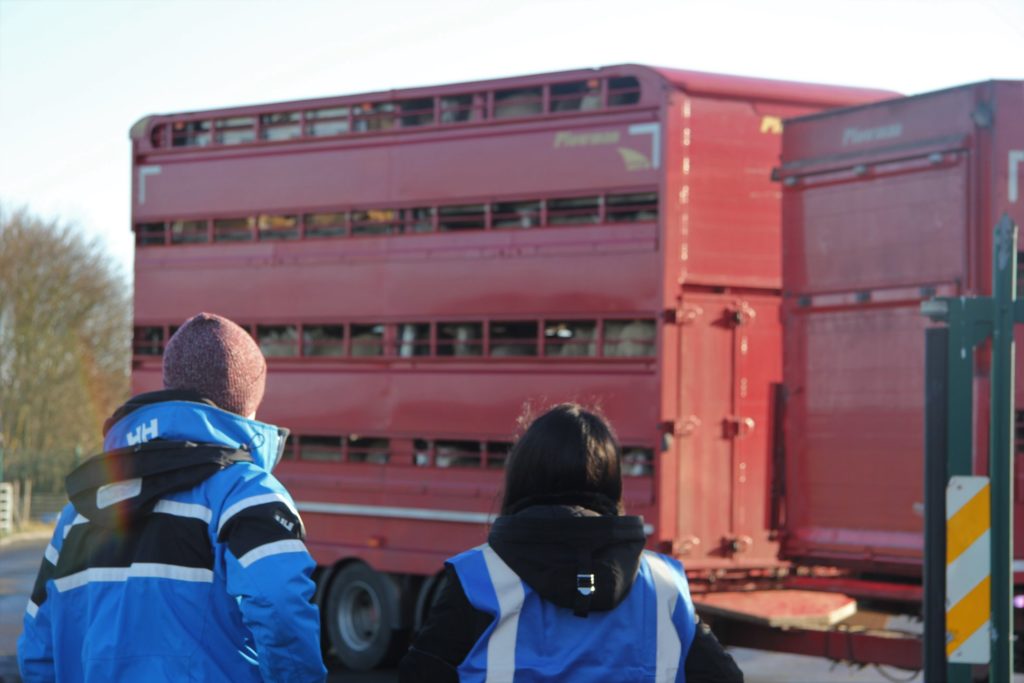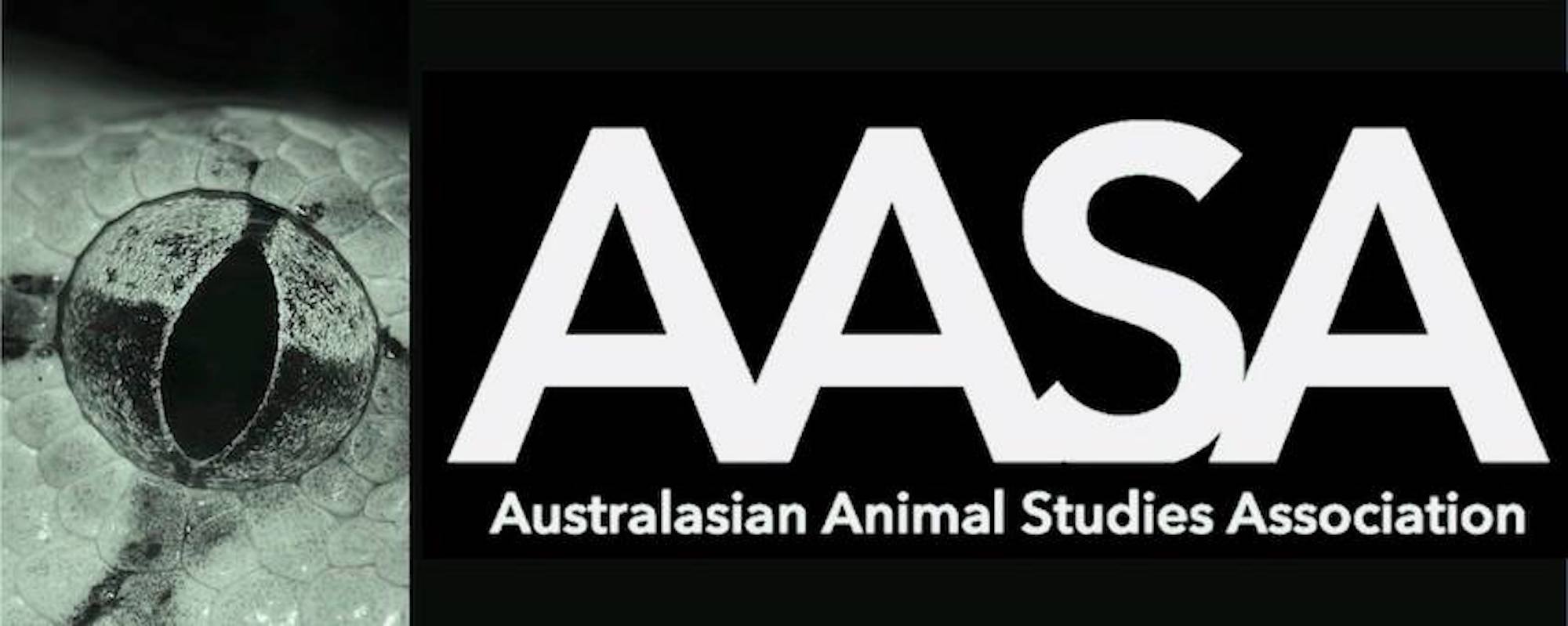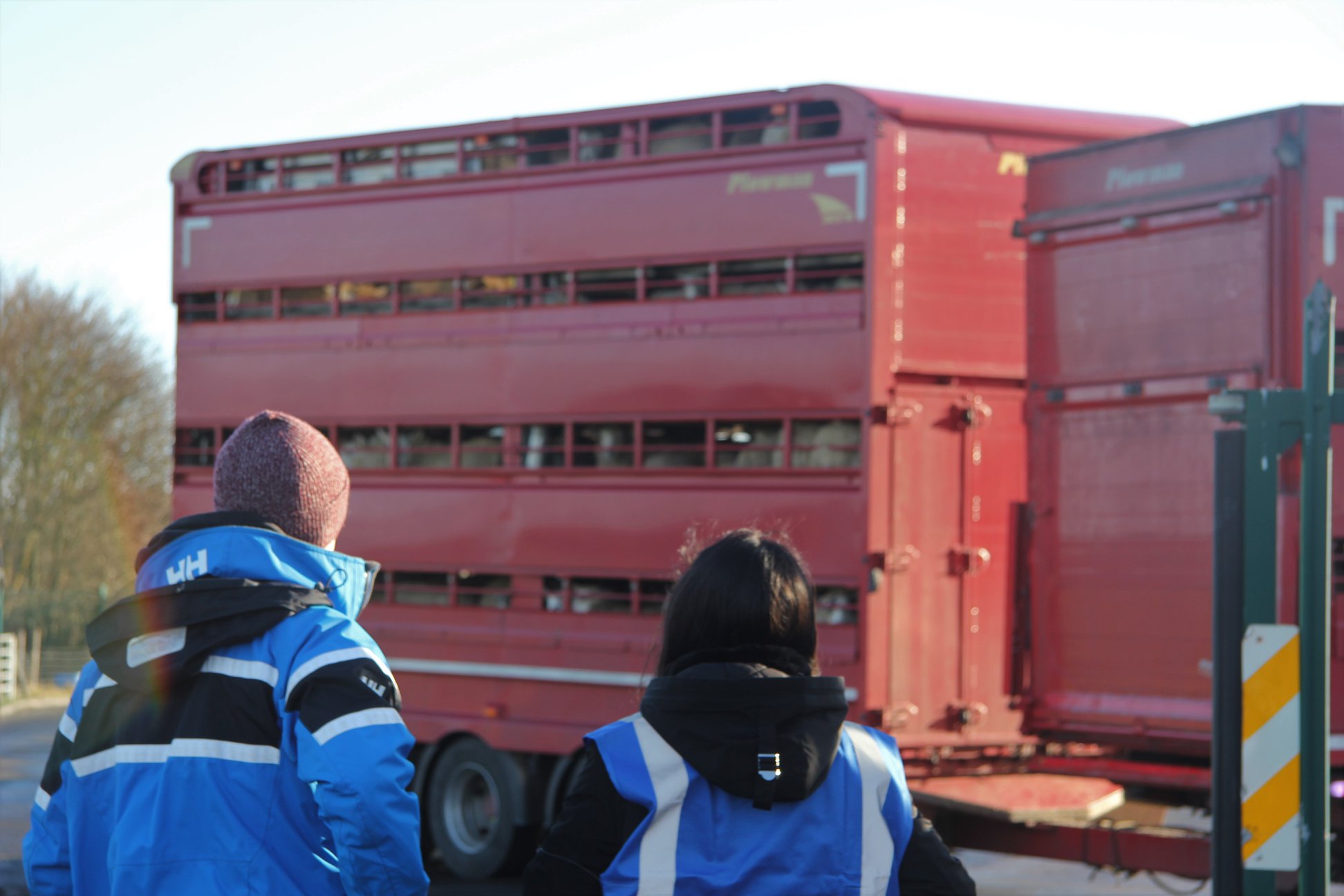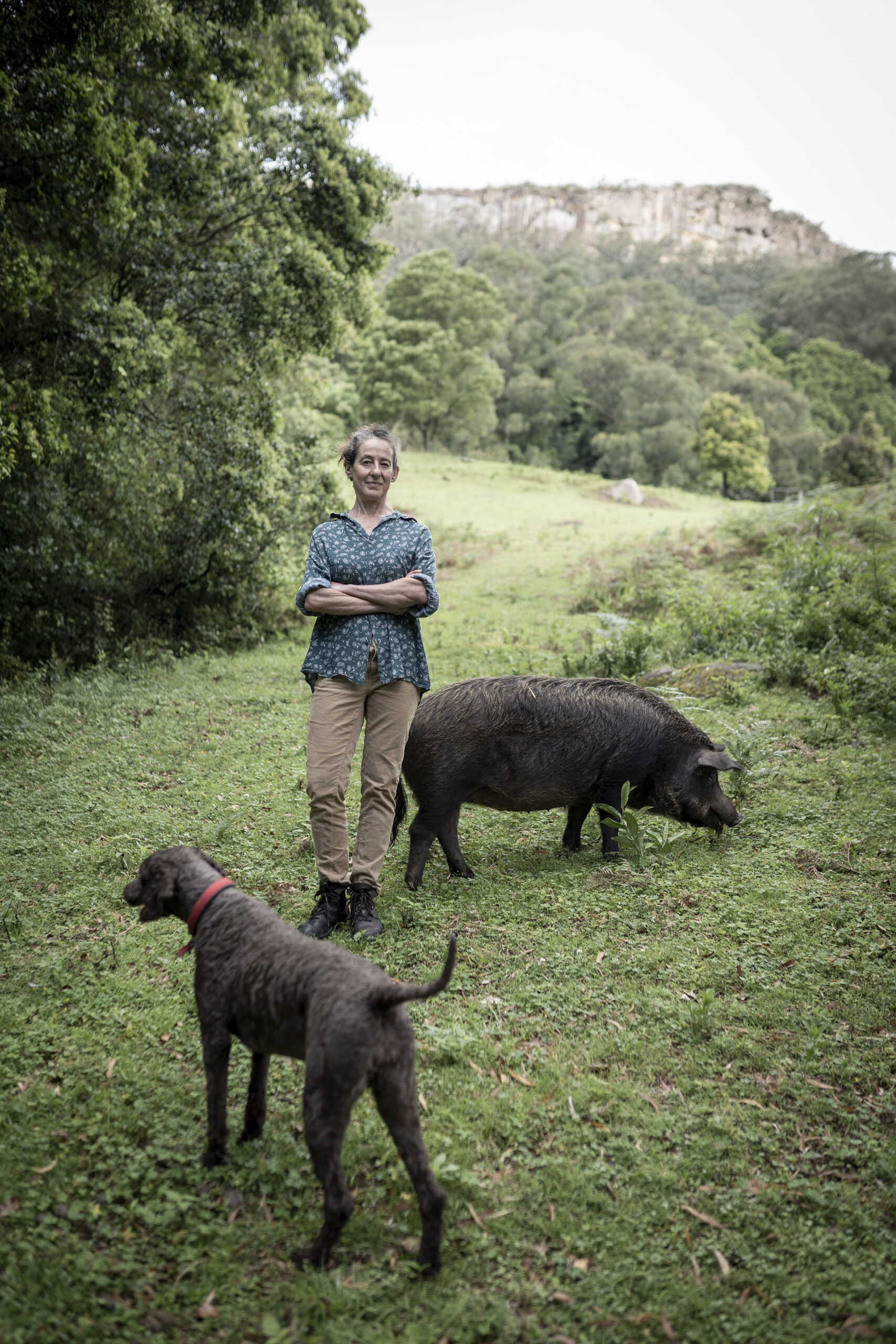Alex Lockwood is a writer, activist and public speaker. Please visit his website for more info and updates: http://alexlockwood.co.uk/

‘It’s a busy one today,’ says the guy with the goatee beard, who we often talk to as he arrives for work. He does shoulders with a boning blade. ‘About nine hundred.’
We absorb the news. We’ve already seen about a hundred sheep on one truck, which arrived about 6.30am. The trucks tend to follow a pattern: one or two large ones early, then a gap with perhaps a few local trailers carrying one to six animals, and then more large transports around 9am. We were originally concerned that the slaughterhouse would stop their arrivals if they knew we were present, and so made our vigils private. But the trucks keep coming.

When the next truck arrives, we follow our usual routine. We stand around not looking like we know the truck is on its way, not to alert the worker who monitors the gate. Then as the truck emerges from behind a small copse of trees lining the road, we grab our signs, and three or four of us stand in front of the gate, still closed, holding up placards. No hate for drivers, only love for the animals, says one. Please give us three minutes to say goodbye, another.
This driver has a double decker, but it’s short, perhaps eighty sheep. I don’t recall seeing him before. He has to get out of the truck and buzz the buzzer for the gate to open. Many of our activists in their blue hi-viz (not yellow or orange, which can traumatize the animals) approach the slats where the sheep are visible, and through which the sheep can see, smell, and touch us, if we come close. I don’t usually go towards the animals for a few reasons: one) my camera is rubbish, and two) I’ve been doing this now for nearly five years, and three) I am conscious of the criticisms I hear about how this can make things worse for the animals. But today I do, a bit. Or rather, I turn and watch the other activists get the footage with their cameras, who offer the sheep their fingers to sniff at, as I do to my cat when I arrive home. With the driver back in his cab, when the gate begins to open, but not yet wide enough to drive through, he revs the engine and jumps the truck forward provocatively. It’s dangerous. Most don’t do this. Most edge forward and nudge us out of the way. If he lost control, he would pin three of us between truck and gate. I’m worried for my friends, and I bang on the driver’s window, shouting, Wait, Wait. We make eye contact, but what attracts my attention most is his arm, resting by the window. It is shaking. He is shaking. When the gate is opened enough he speeds in. At the unloading area he has to turn around and wait. The previous truck is still there. So what was the rush anyway? I say out loud.
The gate closes. We all turn away.

*
That was February 19th, 2019, at the Linden Foods abattoir, in Burradon, near Newcastle in the North East of England. These public vigils organised by the Save Movement are now nearly nine years old, and so I won’t do what we writers, scholars, journalists and activists have nearly always done up to this point when writing about them—provided a full synopsis of inception, history, and purpose—because I am hoping that now, that nearly a decade into this form of animal advocacy, the reader will know the backstory. (Or just click on the links.) But what I will do is spend a bit of time reflecting upon my relationship with these public vigils. For nearly five years now (my first vigil was in June 2014) I have been an organiser who has promoted them, an academic who has studied them, and a writer who has explored them, and I have become an advocate who cannot separate out their practices from the explosion in vegan awareness in the past 5-10 years in the countries where such vigils have gained traction, such as the United Kingdom. Part of this reflection will be on the continued and important criticisms of the ways in which they are carried out, and the effects they have had on the nonhuman animals as well as the humans involved.
*
The brief flare of anger and conflict with the driver is not as common as the friendly, conversational interaction with the shoulder butcher, now we have been conducting these vigils in the same spot for the last two years. The same is true, more or less, worldwide. Initial misunderstanding, fear and distrust has settled into, in most places, ambivalence – the slaughterhouse owners and workers know we don’t (can’t) really disrupt their work for very long – and in some cases there is grudging respect, and even agreements on operational aspects of the public vigils. If there are now over 600 groups of the Save Movement worldwide, conducting on average two vigils a month, that’s nearly 15,000 public vigils every year that pass by almost exclusively without incident, criminal activity, or much reportable conflict. Where there is violence or insults, it is, in my experience, suffered by the activists at the hands of drivers; activists are shouted at, pushed around by the trucks, have meat products thrown at them, and are questioned on their viability as members of a functioning society (‘get a job!’ – I’ve got one thanks).
Like many who bear witness to this transport of animals trapped within exploitative agribusiness, I believed back in 2014 and still believe now that the activity of bearing witness is a profoundly transformative one, and – perhaps – a moral duty for all those who live where suffering occurs. Which is, of course, everyone.
My experience in attending and studying vigils is that it transforms those who attend: as many have written, we cannot unsee what we have seen; this ‘seeing’ changes who we are. As Kelly Oliver, Kathie Jenni, Melanie Joy, Teya Brooks Pribac, and other scholars of witnessing have authorized us to consider, bearing witness is affective: we feel it in our bodies and bones, and the energies of how we witness (grief, fear, anger, loss, trauma) impact our bodies and begin to shift our identities.
Bearing witness in this way can also be at the root of, says Kelly Oliver, a much more just, sustainable and pleasurable form of subject formation that creates subjectivity in social life, but not at the expense of the ‘othered’ other. Witnessing in this way – with what many have called entangled, moral, or loving attention – exposes the hierarchies implicit in the suffering of one being at the hands of another. Witnessing the sheep who is owned by the farmer and slaughtered by the slaughterer and eaten by the carnivore is a means to transform that hierarchical process by which subjects and objects are formed. Bearing witness closes the gap between the human and nonhuman, not merely by sharing the same spatiality, but also ontologically, by redefining the process of witnessing so that it is not carried out by a distant gaze across a hierarchical abyss of meaning, but takes place through energy: wave, particle, air, smell her, her wool, and hear her trying to keep her balance as the truck lurches forward, her saliva on your fingers as the truck rushes away. If “our use becomes their ontology” as Karen Davis says, revising our uses can shift their meaning.

Witnessing at these public vigils reforms how subjects form, by reacting to action that de-instrumentalizes the nonhuman animal, with the purpose to give the sheep back her valid subjectivity: as a being who deserves to live out her species-specific life to its fullest potential. We honour ourselves with such graces and privilege. Why not our fellow creatures?
*
At the vigil, L shows me her photos. We see the brimming bright pink collars of the sheep cut back to their shoulders, their wool almost standing on end. They have been sheared this way, to look like Mods or Mozart, with their high stiff standing frills of wool, so the slicer can more easily slit their throats. Such knowledge changes; we come to know what it is we humans do to other beings.
For some reason, this transformative experience for the activists who do bear witness is often criticized. The criticism is that the vigils are ‘more for the humans than for the animals’ in that no animals are ‘saved’ and instead the activists get to go home having felt they have done their duty, benefiting by living aligned to their values. I’ll deal with the criticisms below.
But we can’t help how transformation happens. As we come to understand not just more about nonhuman animals but more about ourselves and the ways our bodies shape our experiences, we see that transformation comes through bodily knowing, embodied encounters, and the removal of barriers between each other. Our bodies shape social worlds, as the sociologist of the body Chris Shilling puts it simply. Our relationality and connection to others is what shapes us and forges the ways we live. When we then go to the slaughterhouse, or to any other place where the nonhuman is suffering and prevented from living their species-specific life to its fullest potential, we understand a little, then a lot, about the ways in which our social worlds are highly, viciously, violently anthropo -genic and -centric.
I like what Pribac writes in her essay ‘Grieving at a Distance’ about the nature of our social worlds, currently constructed as they are around the hiding away of things. The exploitation of animals is hidden within a system that we don’t often see; this lack of awareness disallows their species-specific lives and all the potential they could experience when those lives are cut short; they are cut short because the nonhuman animals are only considered, by the norms of our society, to be property, products, profitable enterprises, an agglomeration of materials for making into parts that satisfy human needs, from cloak to bedding to medicine to gelatine. What Pribac writes, drawing on Sullender, is that the violence done to animals is hidden away because it runs counter to our instinctual desire to come to their aid. And that we are protecting ourselves by not looking. Yet hiding things away to protect ourselves means “we are not growing safer and stronger, but more fragile and more vulnerable, both as individuals and as a society, heading toward sociopathy and a devastating internal split” (197).
*
We walk around the back of the slaughterhouse to see if we can get footage of the sheep held in lairage. There’s a small gap in the corrugated iron fencing. We’re fifteen feet away, but the sheep, curious as well as afraid, can smell and hear us. Workers are moving around in their blue overalls and white hardhats. They see us taking pictures and two come along with a long piece of plywood which they use to plug the gap in the fence. Now we see only the sheep’s feet as they are shifted into the production line, to have the bolt blasted through their skulls and be eviscerated into all the parts most humans still think it is okay to eat.
Three of us talk about how we cope. About the distance and detachment that is practiced to hold off the overwhelming emotions when seeing the animals taken in. We speak of a determined numbing, a defencing off from the scene that allows people to carry on.
Something concerns me with this. We have a limited vocabulary to express how we cope with what overwhelms us; the dominant narrative is one of withdrawal, detachment, numbing. But while there are boundaries to maintain when faced with traumatic events, detachment as a coping strategy is not a healthy response. It is when we allow emotions to be felt and pass through us that they’re processed. This way, they don’t get stuck in the body as trauma. Allowing emotions to pass expands our capacity for experience, as we practice an orientation towards the pain and learn how to remain open. It is this openness to the traumatic scene, bounded with safe space or loved ones to share with and run to, that allows us to carry on. Not detachment. This is the healthy expression of bearing witness.
Bearing witness is a re-sensitization to the world, not a de-sensitization. Bearing witness allows us to respond appropriately, with empathy and understanding of the range of lived experiences for all beings. Bearing witness this way allows us to respond appropriately to this slaughter of sentient beings. We are re-sensitized, we open ourselves to the necessity for compassion. The actions that flow from bearing witness show that we do not detach from the experience. Although the intensity passes, its resonance in our bodies is a vibration of compassion. It is a closeness to the animals’ bodies that amplifies this. Their creatureliness and ours, together, is our shared material and biological vulnerability. We can both be killed. It is this that makes that everything count. It is impossible to ignore this accountability when bearing witness with careful attention and to carry bearing witness forward to the next stage of activity: testimony.
So, I explain it like this: when you go to the gym, you bear weights as a way to strengthen yourself so that in the future you are able to bear more weight and grow stronger. It is the same, I believe, for bearing witness. As we bear witness to the suffering of others, we are growing stronger and safer and less dysfunctionally normative. More resilient. Our witnessing allows us to see how wrong it is to structure our social worlds around a hidden set of cruel practices; to put all that energy into concealing and denying what runs counter to our instinctive wishes for all beings to flourish, live safely, and see others flourish. Bearing witness at these public vigils is a means to grow individual strength and safety, and also to transform our social worlds into healthier, stronger, safer places. For humans as well as nonhumans.
*
But then, over the last five years, I’ve veered away from the animals in the trucks to instead put my body in front of the truck. Is this so that I cannot see? Or is something else going on here? The strongest, most meaningful and important criticisms of these public vigils has come not from agribusiness interests and farmers (their quarrels are pretty easy to argue against) but from those wholly entangled with animal bodies: people who run animal sanctuaries, whose lives are fully immersed in multispecies existences; those people who know much more about the subjectivity of the cow or the pig or the sheep, than me.
The main criticism, one that it is almost impossible not to accept, is this: that the presence of the activists makes the situation more stressful for the animal inside the trucks. With animals who have almost certainly not had good experiences of humans to learn to trust them; and with animals stressed by the difficult journeys in the trucks, with no water or food, what right do the activists have to impose their cameras and smells and fingers into the trauma the animal is already experiencing? Then, if the activists’ presence makes the drivers more aggressive – like our shaking driver that morning – the animals will be thrown around further in the back.
There is potential for this at every vigil. But in the UK, an animal best practice group was set up, with members of different Saves from around the country forming a working group to develop guidelines for the minimizing of stress for the animals. A limited number of activists approach the trucks, always from the side of cows and sheep, not head on, in blue hi-viz not yellow, in silence, with no loud noises, and no flash, and no strong-smelling foods or chemicals. Water is offered, but not forced upon the animals if they refuse.
Many of the main points are listed in the Save Movement’s Code of Conduct, on their website, under the heading Respect for Animals. Inside the starter packs, and in communication with the new group support teams around the world, these elements are discussed in even further detail.
But there is no clear line. It is likely that the presence of activists have, for a few brief moments, made the worst day of the animals’ lives worse. And that is truly regretful, because everyone present is there to see an end to this kind of exploitation and suffering, and finding a way to help, not to further stress the animals. I no longer approach the trucks myself. For me, it is enough to be there, bearing witness at a distance, and to be seen, importantly, by others bearing witness, to normalize this act of standing up and speaking out for our animal kin.
Is it worth it? That is an impossible question for me to answer.
The other serious criticism is to do with privacy. The animals have not asked for us to attend their worst days, nor to mediatize their trauma. How do we show respect for these individual animals in doing so? Again, there is no answer that refutes this criticism. But as I’ve written elsewhere, I believe that the incredible shifts in public perceptions and attitudes towards veganism would not have gained the traction they have without the work of Save activists, as well as other advocates for animals, doing the hard work of raising awareness to the ways in which animals are treated when they are hidden from our sight. What we have been doing is bringing sensibility to the animals in the bottom right-hand quadrant of Matthew Cole and Kate Stewart’s “anthroparchal conceptual map” they write about in Our Children and Other Animals, the killing zone, where the industrial slaughter, vivisection and ‘pest’ control take place. We who bear witness step into that killing zone and publicize it, because those who profit from animal exploitation know that the intermingling of species is too dangerous to their business goals.
There are other criticisms, these ones more easily refuted:
- As mentioned above, the vigils are ‘more for the humans than for the animals’. But this could be said for nearly all activism that does not directly rescue animals from their exploitation in the industry. Even vegan outreach on the streets that aims to turn people vegan only ‘saves’ future animals, not existing animals. And anyway, the criticism has no evidence. That bearing witness at public vigils can be transformative for those involved is more likely to lead to future reduction in harm for animals than not, by strengthening the resolution of those present to work for animal liberation and to share what they have seen, creating more vegans and activists along the way.
- That the activists are wasting their time on what is effectively a Single-Issue Campaign of reducing suffering for animals going to slaughter, and should instead be spending every second on helping as many people as possible go vegan. This, from the Francione-inspired abolitionists, fundamentally misunderstands the public vigils, which are grounded in the goal of creating more vegan activists through vigil attendance, belief change, and media distribution, amplifying the numbers working towards helping others go vegan.
- That the Save movement does not ‘save’ any of the animals in the trucks. Although every now and then, and in infinitesimally small numbers compared to those who lose their lives, some animals are saved and taken to sanctuaries. But the public vigils are held in within non-vegan societies where animals are considered under law as property, and their aim is awareness-raising. The name is not misleading but aspirational.
I am enthusiastic to see how the Save Movement, and the willingness to hold public vigils of this kind by other organisations, such as Anonymous for the Voiceless and Animal Equality, continues to shape public attitudes towards animals and veganism over the coming years. I am committed to bearing witness as a compassionate, transformative act, and the belief, which Melanie Joy articulates across her work, that it is collectively bearing witness to injustice that leads to social and political change. That the vigil is public, and seen, and peaceful, is a powerful component of the changing perceptions in society towards animal advocates too—that it is becoming more normal, and accepted, for all of us to give more care and attention to all the nonhuman lives we share this world with. And, considering what we have done to them these last ten thousand years, especially the cows, pigs, sheep, turkeys, ducks, fishes, and other beings we have continually and violently used for food.



